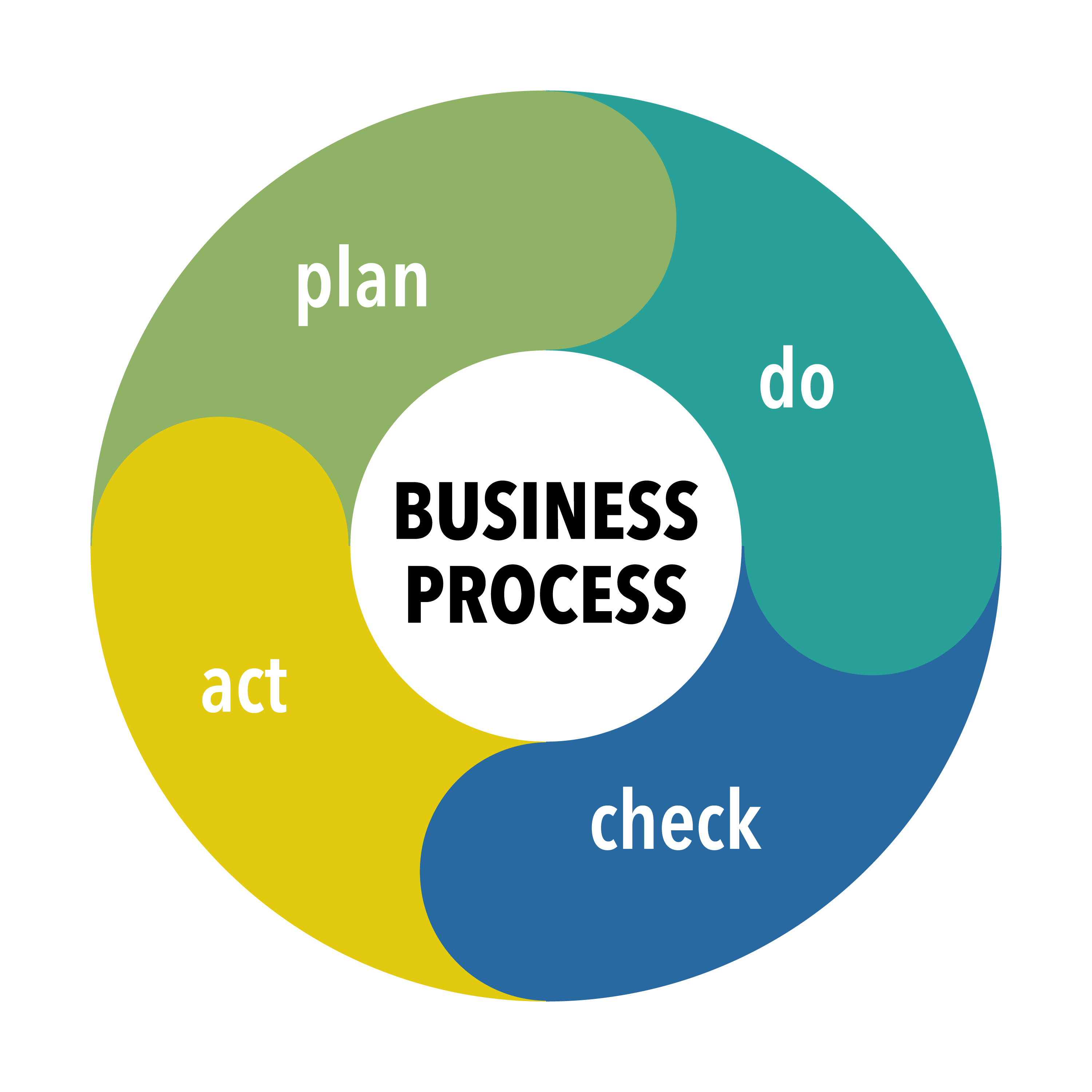We have discussed the importance of continuous improvement earlier in this programme, but why is it so important and how can you implement it in your hospitality business? You will recall that continuous improvement is a process which is aimed at consistently enhancing performance, methods and products within both organisations and their individual members. It requires a commitment to ongoing growth, innovation and an ability to learn from mistakes and accept change.
The process of continuous improvement aims for excellence by identifying the areas where incremental changes can lead to improved outcomes (What Is Continuous Improvement?, 2023).
The Plan-Do-Check-Act (PDCA) cycle of continuous improvement is an approach which is used by managers to drive incremental improvements in business operations to enhance service quality, operational efficiency and guest satisfaction.
- Plan: The first step involves identifying an opportunity for improvement and developing a plan to address it. This could include setting objectives, gathering data, and determining resources needed. The planning phase is critical as it lays the foundation for effective changes.
- Do: In the "Do" phase, the plan is implemented on a small scale to test its impact. By starting small, managers can assess whether the proposed changes are effective before committing to full-scale implementation. The "Do" phase allows for trial, observation, and adjustments.
- Check: Once the plan is executed, the next step is to assess the results. During the "Check" phase, data is collected and analysed to see if the changes met the objectives set in the planning phase. This evaluation process helps determine whether the improvement efforts are successful or if further adjustments are needed.
- Act: Based on the results from the "Check" phase, management can either standardise the successful changes across the operation or refine the plan and cycle through the process again. The "Act" phase ensures continuous improvement by either implementing the improvement on a larger scale or revisiting the cycle for additional refinements.
Case Study
Continuous Improvement at Pauanui Ocean Resort

Pauanui Ocean Resort has been receiving feedback from guests that the check-in process is slow, leading to delays and dissatisfaction, especially during peak holiday periods. The management team decides to use the PDCA cycle to improve this part of the guest experience.
Plan: The resort's management begins by analysing the root causes of the check-in delays. They discover that the bottleneck is due to insufficient staff during peak check-in times and outdated systems that require manual data entry. To address these issues, the management develops a plan:
- Increase staff during peak hours.
- Introduce an online check-in system to speed up data processing.
Do: The resort decides to trial this plan over a one-month period, focusing on weekends when guest arrivals are at their highest. They schedule two additional staff members for check-in during these times and introduce the online check-in system to guests booking directly through the resort’s website.
Check: After the trial period, the management collects feedback from both guests and staff. They find that the online check-in system reduced the average check-in time by 30%, and having additional staff during peak hours improved the guest experience significantly. However, some guests encountered technical difficulties with the online system.
Act: Based on the feedback, the resort decides to fully implement the online check-in system with additional training for staff to assist guests who encounter issues. They also plan to further promote the online system to encourage more guests to use it before arrival. The increased staffing levels during peak times will remain in place, as they have proven effective in reducing delays.
The process of continuous improvement within hospitality operations is significant as it helps to drive both operational efficiency and guest satisfaction. Through the PDCA cycle, hospitality businesses can make incremental improvements to areas such as check-in, housekeeping and service delivery. There can be benefits of reduced inefficiencies, proactive problem-solving and can lead to better staff performance, guest loyalty and ultimately higher profitability. Continuous improvement encourages innovation, adaptability and resilience.
Key Techniques Recap: Earlier in the programme we looked at some key techniques to implement continuous improvement:
- Lean Management: Lean management focuses on reducing waste and improving flow in processes. Common lean tools include 5S (Sort, Straighten, Shine, Standardise, Sustain) and Kaizen (continuous improvement). Click the links above for more information on the 5S and Kaizen and read this for more general information on the concept of lean management.
- Six Sigma: Six Sigma is a data-driven approach to improve business processes developed in the 1980s. It uses statistics, financial management and project management to reduce errors, minimise variation and increase quality and efficiency (known as DMAIC methodology – Define, Measure, Analyse, Improve, Control).
- TQM (Total Quality Management): TQM is another method of continually detecting and eliminating errors in order to improve customer experience, efficiencies, staff morale and competitive advantages. More information on TQM can be found here.
One of the most important methodologies for continuous development in the Six Sigma approach. This is a structured and data-driven system which aims to improve quality and efficiency within an organisation by reducing inconsistency and defects in processes. The Six Sigma Approach is built on a set of core principles which guide its application:
- Focus on Customer Requirements: At the heart of Six Sigma is a strong emphasis on understanding and meeting customer expectations. For a hospitality business like Pauanui Ocean Resort, this involves listening to guest feedback and identifying the critical factors that impact the guest experience, such as timely service, cleanliness, and quality of amenities. The ultimate goal is to ensure that the product or service consistently meets or exceeds customer standards.
- Data-Driven Decision Making: Six Sigma relies heavily on data collection and statistical analysis to understand process performance and identify areas for improvement. Rather than relying on assumptions or guesswork, hospitality managers gather quantitative data related to key operations, such as booking times, check-in efficiency, or guest complaints. This data is used to uncover root causes of inefficiencies or defects, allowing for evidence-based decisions and targeted solutions.
- Elimination of Variation: In any process, variation leads to inconsistency, which can result in defects and lower service quality. For hospitality businesses, variation might manifest as fluctuating service standards, inconsistent food quality, or varying room cleanliness. Six Sigma focuses on minimising variation by standardising processes, ensuring that every guest receives the same high level of service.
- Continuous Improvement: Like the PDCA cycle, Six Sigma emphasises the importance of ongoing, incremental improvements. By identifying areas where processes can be optimised, hospitality managers can make continuous adjustments to enhance operational efficiency. This aligns with the industry’s need to adapt to changing guest expectations and market trends.
- Employee Involvement: Successful Six Sigma initiatives depend on the active involvement of all employees, from top management to frontline staff. In hospitality, this means encouraging all team members to contribute to improvement efforts. For example, housekeeping staff may provide insights into how cleaning protocols can be streamlined, or front desk agents may highlight ways to improve the check-in process. This collective approach fosters a culture of shared responsibility and innovation.
- Structured Problem-Solving: The Six Sigma methodology uses a structured problem-solving approach, typically referred to as DMAIC: Define, Measure, Analyse, Improve, and Control. This process ensures that improvements are systematic and sustainable, addressing the root causes of problems rather than treating symptoms.
The DMAIC Framework
- Define: The first phase in the DMAIC framework is to clearly define the problem or improvement opportunity. In a hospitality setting, this might involve defining an issue such as frequent guest complaints about room readiness or long wait times at the restaurant. At this stage, it is crucial to set clear goals and objectives, ensuring that improvement efforts are aligned with both business and guest needs.
- Measure: In the Measure phase, relevant data is collected to understand the current performance of the process in question. For example, if the goal is to improve the speed of the check-in process at Pauanui Ocean Resort, the management might measure the average time it takes for guests to complete check-in procedures during peak hours. This data provides a baseline for comparison after improvements are implemented.
- Analyse: During the Analyse phase, the collected data is examined to identify root causes of the problem. For example, if room service delays are being investigated, data analysis might reveal that delays are linked to inefficient coordination between the kitchen and housekeeping departments. By pinpointing the underlying causes of inefficiencies, hospitality managers can develop more effective improvement strategies.
- Improve: In the Improve phase, solutions are developed and implemented to address the root causes identified in the Analyse phase. For example, if outdated technology is causing delays in guest check-ins, the resort might introduce a new property management system to streamline the process. The improvements are often trialled on a small scale before full implementation, allowing managers to assess their effectiveness and make necessary adjustments.
- Control: The final phase, Control, focuses on ensuring that the improvements are sustained over time. This involves implementing monitoring systems to track ongoing performance and make sure the process does not revert to its previous state. In hospitality, this could mean regularly reviewing guest satisfaction surveys, monitoring process performance metrics, and providing ongoing staff training.
Application of Six Sigma in Hospitality
In a hospitality business like Pauanui Ocean Resort, the Six Sigma approach can be applied to various operational areas to improve service delivery and customer satisfaction. Examples include:
- Room Readiness: Six Sigma can help optimise housekeeping processes to ensure rooms are cleaned and ready for guests promptly, reducing wait times during check-in.
- Food and Beverage Services: By analysing and improving the time it takes to prepare and serve meals; Six Sigma can enhance guest dining experiences.
- Guest Complaints Management: Six Sigma’s data-driven approach can be used to identify recurring guest complaints and develop systematic solutions to address them, resulting in a more consistent and higher-quality guest experience.
- Staff Efficiency: The method can be applied to employee scheduling and task allocation to ensure that staffing levels meet guest demand without overstaffing or under-staffing, optimising operational efficiency.
Benefits of Six Sigma in Hospitality
- Enhanced Guest Experience: By reducing defects and inconsistencies in service delivery, Six Sigma helps ensure that guests have a consistently positive experience, increasing guest loyalty and encouraging repeat business.
- Increased Operational Efficiency: By identifying and eliminating waste Six Sigma helps hospitality businesses streamline their operations, leading to faster service times, better resource management, and cost savings.
- Improved Employee Satisfaction: Six Sigma empowers employees by involving them in the problem-solving process, leading to a more engaged and motivated workforce.
- Competitive Advantage: As hospitality businesses continue to focus on service quality and customer satisfaction, Six Sigma provides a framework for gaining a competitive edge through continuous improvement and operational excellence.
H5P here
You’ve reached the end of the learning material for this topic. Let’s recap the key points, and then make sure you’ve completed all the and activities and checked out all of the linked information. In this topic we’ve looked at:
- The Plan-Do-Check-Act cycle of continuous improvement
- Impacts of continuous improvement
- The Six Sigma approach
- The DMAIC framework
